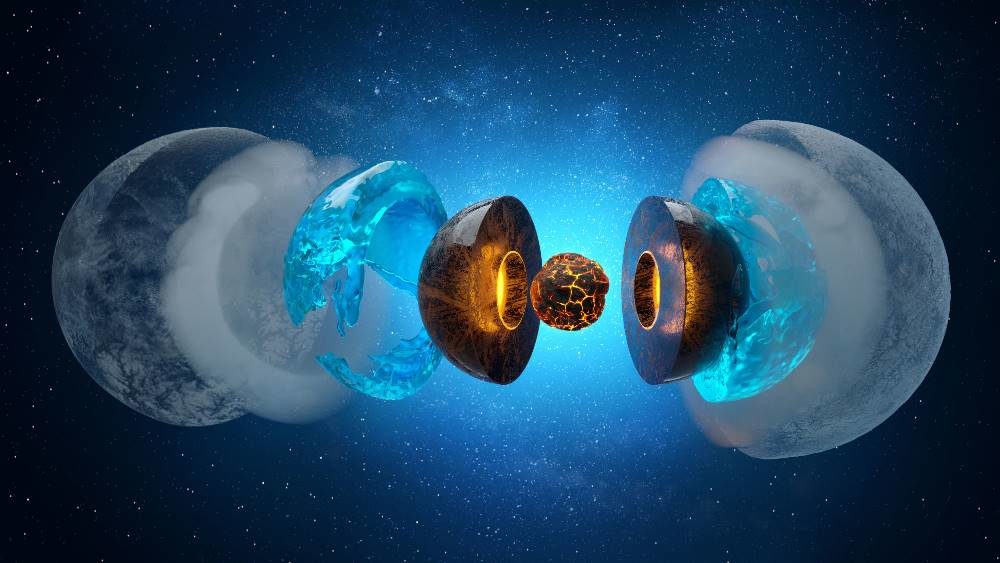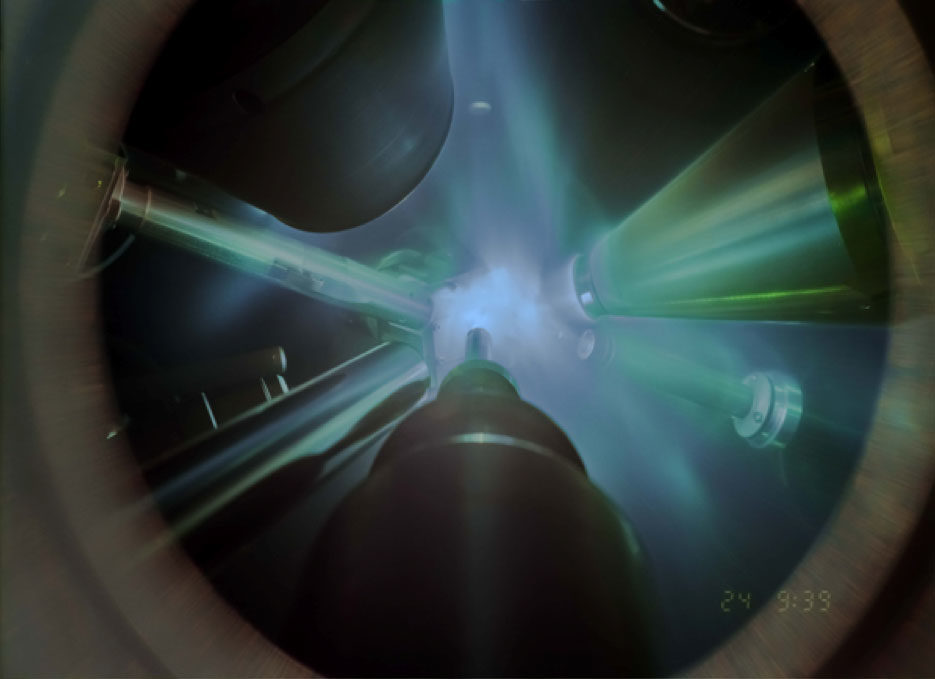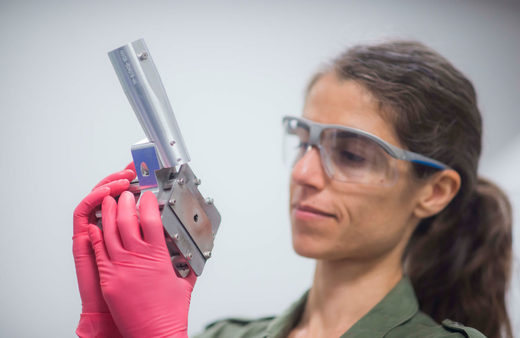
Recently at the Laboratory for Laser Energetics in Brighton, New York, one of the world's most powerful lasers blasted a droplet of water, creating a shock wave that raised the water's pressure to millions of atmospheres and its temperature to thousands of degrees. X-rays that beamed through the droplet in the same fraction of a second offered humanity's first glimpse of water under those extreme conditions.
The X-rays revealed that the water inside the shock wave didn't become a superheated liquid or gas. Paradoxically - but just as physicists squinting at screens in an adjacent room had expected - the atoms froze solid, forming crystalline ice.
"You hear the shot," said Marius Millot of Lawrence Livermore National Laboratory in California, and "right away you see that something interesting was happening." Millot co-led the experiment with Federica Coppari, also of Lawrence Livermore.
The findings, published today in Nature, confirm the existence of "superionic ice," a new phase of water with bizarre properties. Unlike the familiar ice found in your freezer or at the north pole, superionic ice is black and hot. A cube of it would weigh four times as much as a normal one. It was first theoretically predicted more than 30 years ago, and although it has never been seen until now, scientists think it might be among the most abundant forms of water in the universe.
Across the solar system, at least, more water probably exists as superionic ice - filling the interiors of Uranus and Neptune - than in any other phase, including the liquid form sloshing in oceans on Earth, Europa and Enceladus. The discovery of superionic ice potentially solves decades-old puzzles about the composition of these "ice giant" worlds.
Including the hexagonal arrangement of water molecules found in common ice, known as "ice Ih," scientists had already discovered a bewildering 18 architectures of ice crystal. After ice I, which comes in two forms, Ih and Ic, the rest are numbered II through XVII in order of their discovery. (Yes, there is an Ice IX, but it exists only under contrived conditions, unlike the fictional doomsday substance in Kurt Vonnegut's novel Cat's Cradle.)
Superionic ice can now claim the mantle of Ice XVIII. It's a new crystal, but with a twist. All the previously known water ices are made of intact water molecules, each with one oxygen atom linked to two hydrogens. But superionic ice, the new measurements confirm, isn't like that. It exists in a sort of surrealist limbo, part solid, part liquid. Individual water molecules break apart. The oxygen atoms form a cubic lattice, but the hydrogen atoms spill free, flowing like a liquid through the rigid cage of oxygens.

Depending on whom you ask, superionic ice is either another addition to water's already cluttered array of avatars or something even stranger. Because its water molecules break apart, said the physicist Livia Bove of France's National Center for Scientific Research and Pierre and Marie Curie University, it's not quite a new phase of water. "It's really a new state of matter," she said, "which is rather spectacular."
Puzzles Put on Ice
Physicists have been after superionic ice for years - ever since a primitive computer simulation led by Pierfranco Demontis in 1988 predicted water would take on this strange, almost metal-like form if you pushed it beyond the map of known ice phases.
Under extreme pressure and heat, the simulations suggested, water molecules break. With the oxygen atoms locked in a cubic lattice, "the hydrogens now start to jump from one position in the crystal to another, and jump again, and jump again," said Millot. The jumps between lattice sites are so fast that the hydrogen atoms - which are ionized, making them essentially positively charged protons - appear to move like a liquid.
This suggested superionic ice would conduct electricity, like a metal, with the hydrogens playing the usual role of electrons. Having these loose hydrogen atoms gushing around would also boost the ice's disorder, or entropy. In turn, that increase in entropy would make this ice much more stable than other kinds of ice crystals, causing its melting point to soar upward.
A computer simulation of the new superionic water ice phase is seen below, illustrating the random, liquid-like motion of the hydrogen ions (gray, with a few highlighted in red) within a face-centered cubic lattice of oxygen ions (blue).
(Visualization courtesy of Hamel, Millot, Coppari (LLNL)
But all this was easy to imagine and hard to trust. The first models used simplified physics, hand-waving their way through the quantum nature of real molecules. Later simulations folded in more quantum effects but still sidestepped the actual equations required to describe multiple quantum bodies interacting, which are too computationally difficult to solve. Instead, they relied on approximations, raising the possibility that the whole scenario could be just a mirage in a simulation. Experiments, meanwhile, couldn't make the requisite pressures without also generating enough heat to melt even this hardy substance.
As the problem simmered, though, planetary scientists developed their own sneaking suspicions that water might have a superionic ice phase. Right around the time when the phase was first predicted, the probe Voyager 2 had sailed into the outer solar system, uncovering something strange about the magnetic fields of the ice giants Uranus and Neptune.
The fields around the solar system's other planets seem to be made up of strongly defined north and south poles, without much other structure. It's almost as if they have just bar magnets in their centers, aligned with their rotation axes. Planetary scientists chalk this up to "dynamos": interior regions where conductive fluids rise and swirl as the planet rotates, sprouting massive magnetic fields.
By contrast, the magnetic fields emanating from Uranus and Neptune looked lumpier and more complex, with more than two poles. They also don't align as closely to their planets' rotation. One way to produce this would be to somehow confine the conducting fluid responsible for the dynamo into just a thin outer shell of the planet, instead of letting it reach down into the core.
But the idea that these planets might have solid cores, which are incapable of generating dynamos, didn't seem realistic. If you drilled into these ice giants, you would expect to first encounter a layer of ionic water, which would flow, conduct currents and participate in a dynamo. Naively, it seems like even deeper material, at even hotter temperatures, would also be a fluid. "I used to always make jokes that there's no way the interiors of Uranus and Neptune are actually solid," said Sabine Stanley at Johns Hopkins University. "But now it turns out they might actually be."
Ice on Blast
Now, finally, Coppari, Millot and their team have brought the puzzle pieces together.
In an earlier experiment, published last February, the physicists built indirect evidence for superionic ice. They squeezed a droplet of room-temperature water between the pointy ends of two cut diamonds. By the time the pressure raised to about a gigapascal, roughly 10 times that at the bottom of the Marianas Trench, the water had transformed into a tetragonal crystal called ice VI. By about 2 gigapascals, it had switched into ice VII, a denser, cubic form transparent to the naked eye that scientists recently discovered also exists in tiny pockets inside natural diamonds.
Then, using the OMEGA laser at the Laboratory for Laser Energetics, Millot and colleagues targeted the ice VII, still between diamond anvils. As the laser hit the surface of the diamond, it vaporized material upward, effectively rocketing the diamond away in the opposite direction and sending a shock wave through the ice. Millot's team found their super-pressurized ice melted at around 4,700 degrees Celsius, about as expected for superionic ice, and that it did conduct electricity thanks to the movement of charged protons.
With those predictions about superionic ice's bulk properties settled, the new study led by Coppari and Millot took the next step of confirming its structure. "If you really want to prove that something is crystalline, then you need X-ray diffraction," Salzmann said.
Their new experiment skipped ices VI and VII altogether. Instead, the team simply smashed water with laser blasts between diamond anvils. Billionths of a second later, as shock waves rippled through and the water began crystallizing into nanometer-size ice cubes, the scientists used 16 more laser beams to vaporize a thin sliver of iron next to the sample. The resulting hot plasma flooded the crystallizing water with X-rays, which then diffracted from the ice crystals, allowing the team to discern their structure.

"The fact that the existence of this phase is not an artifact of quantum molecular dynamic simulations, but is real - that's very comforting," Bove said.
And this kind of successful cross-check behind simulations and real superionic ice suggests the ultimate "dream" of material physics researchers might be soon within reach. "You tell me what properties you want in a material, and we'll go to the computer and figure out theoretically what material and what kind of crystal structure you would need," said Raymond Jeanloz, a member of the discovery team based at University of California, Berkeley. "The community at large is getting close."
The new analyses also hint that although superionic ice does conduct some electricity, it's a mushy solid. It would flow over time, but not truly churn. Inside Uranus and Neptune, then, fluid layers might stop about 8,000 kilometers down into the planet, where an enormous mantle of sluggish, superionic ice like Millot's team produced begins. That would limit most dynamo action to shallower depths, accounting for the planets' unusual fields.
Other planets and moons in the solar system likely don't host the right interior sweet spots of temperature and pressure to allow for superionic ice. But many ice giant-sized exoplanets might, suggesting the substance could be common inside icy worlds throughout the galaxy.
Of course, though, no real planet contains just water. The ice giants in our solar system also mix in chemical species like methane and ammonia. The extent to which superionic behavior actually occurs in nature is "going to depend on whether these phases still exist when we mix water with other materials," Stanley said. So far, that isn't clear, although other researchers have argued superionic ammonia should also exist.
Aside from extending their research to other materials, the team also hopes to keep zeroing in on the strange, almost paradoxical duality of their superionic crystals. Just capturing the lattice of oxygen atoms "is clearly the most challenging experiment I have ever done," said Millot. They haven't yet seen the ghostly, interstitial flow of protons through the lattice. "Technologically, we are not there yet," Coppari said, "but the field is growing very fast."
Reference:
M. Millot, F,Coppari, R. Rygg, et. al., "Nanosecond X-ray diffraction of shock-compressed superionic water ice", Nature volume 569, pages 251-255 (2019) doi.org/10.1038/s41586-019-1114-6
Joshua Sokol is a freelance science journalist in Boston. His work has appeared in New Scientist, The Atlantic, The Wall Street Journal and elsewhere. He has a bachelor's degree in astronomy and in English literature from Swarthmore College, and a master's degree in science writing from the Massachusetts Institute of Technology. In between, he worked as a data analyst for the Hubble Space Telescope's Advanced Camera for Surveys.



Reader Comments